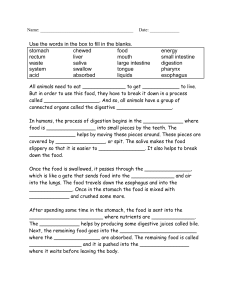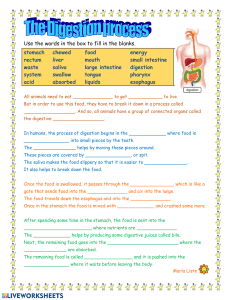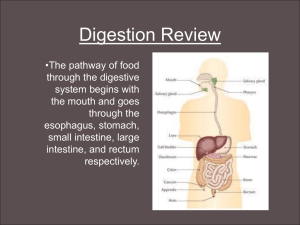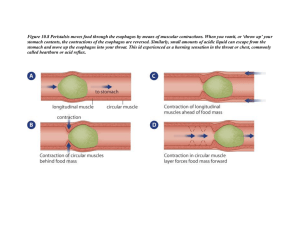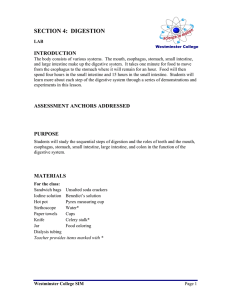The Act of Digestion: Let's Make Poop
advertisement
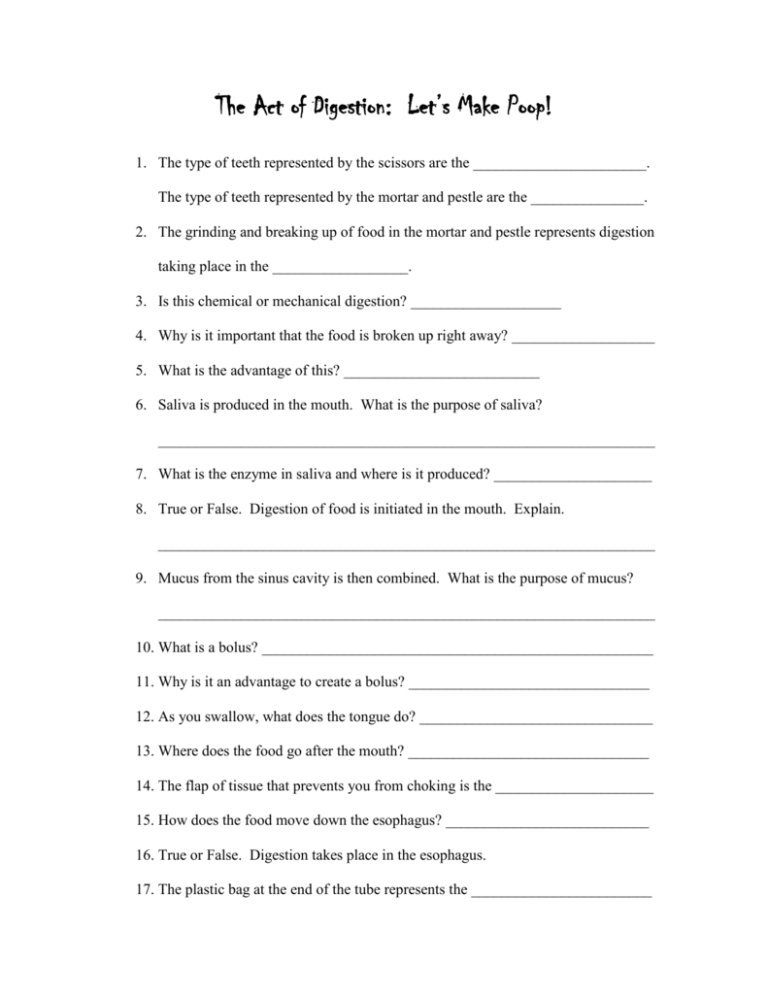
The Act of Digestion: Let’s Make Poop! 1. The type of teeth represented by the scissors are the _______________________. The type of teeth represented by the mortar and pestle are the _______________. 2. The grinding and breaking up of food in the mortar and pestle represents digestion taking place in the __________________. 3. Is this chemical or mechanical digestion? ____________________ 4. Why is it important that the food is broken up right away? ___________________ 5. What is the advantage of this? __________________________ 6. Saliva is produced in the mouth. What is the purpose of saliva? __________________________________________________________________ 7. What is the enzyme in saliva and where is it produced? _____________________ 8. True or False. Digestion of food is initiated in the mouth. Explain. __________________________________________________________________ 9. Mucus from the sinus cavity is then combined. What is the purpose of mucus? __________________________________________________________________ 10. What is a bolus? ____________________________________________________ 11. Why is it an advantage to create a bolus? ________________________________ 12. As you swallow, what does the tongue do? _______________________________ 13. Where does the food go after the mouth? ________________________________ 14. The flap of tissue that prevents you from choking is the _____________________ 15. How does the food move down the esophagus? ___________________________ 16. True or False. Digestion takes place in the esophagus. 17. The plastic bag at the end of the tube represents the ________________________ 18. The muscles at either end of the stomach are called the _____________________ 19. The gastric glands in the stomach secrete ___________________, which functions to dissolve minerals and kill bacteria, ______________, which functions to protect the stomach from digesting itself, and ______________, which functions to break down protein into smaller units. 20. True or False. The stomach can contract and move. 21. The material contained in the stomach is called _______________________. 22. The tubing which the food moves to next represents the ____________________. 23. Digestion is complete in the first part of the small intestine known as the _________________. 24. What type of muscle is found in this and other digestive organs? _____________. 25. ___________________ is produced in the liver, stored in the _________________ and its job is to ____________________________. 26. ______________________ is produced in the pancreas and its job is to _______________________________. The pancreas also produces bicarbonate which ________________________________. 27. _______________________ are produced in the small intestine and their job is to ________________________________________________________________. 28. What is the name of the finger like projections in the small intestine? _______________. Why are they found here? ____________________________ 29. True or False. Starch, proteins, and lipids are absorbed here. Explain. __________________________________________________________________ 30. As I pour the material from the small intestine into the next structure what do you observe happening? _________________________________________________ 31. What is this unknown structure and what is its function? __________________________________________________________________ 32. What would happen if this structure did not function? ______________________ 33. Bacteria live in this structure. What vitamins do they produce? ______________ 34. Feces would most likely be found in the ________________________. 35. Waste exits this structure through the sphincter called the _________________. 36. True or False. The digestive system chemically breaks down food. 37. True or False. The digestive system mechanically breaks down food. 38. True or False. The digestive system absorbs nutrient material. 39. True or False. The digestive system absorbs water and sodium.
